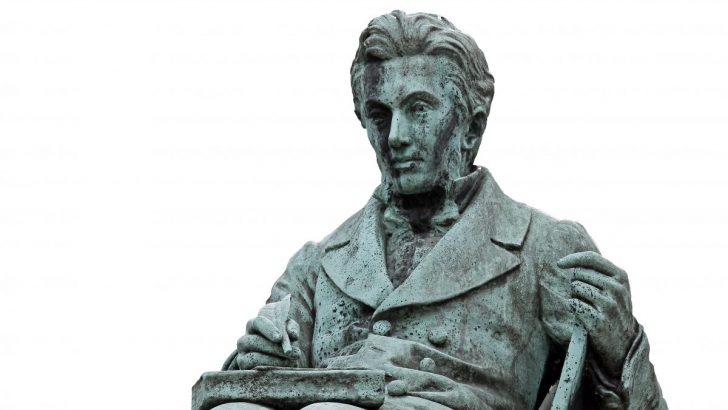Philosopher of the Heart: The Restless Life of Søren Kierkegaard
by Clare Carlisle (Allen Lane, £25.00)
Patrick Claffey
This exploration of the tortured mind and faith of Kierkegaard is a challenging title with which to begin a fresh year of reading.
Clare Carlisle opens her preface to this book on the philosopher with a reference to what was surely one of the three most important relationships of Kierkegaard’s life, with his fiancée Regine Olsen. The others having been with his father and with God.
Following the painful breakup of what was to be his only love affair, Søren wrote: ‘A love affair is always an instructive theme regarding what it means to exist.’ The chill distance of this remark belies the fact that he remained obsessed with Regine, whom he had loved from her childhood, but abandoned less than a year after their engagement, for the rest of his life.
She tells us that Kierkegaard ‘always found Christianity disturbing as well as inviting’, and he certainly despised any attempts to soft-peddle it in any way, particularly in the established Lutheran Church”
The focus of Kierkegaard’s thought was ‘what it means to exist’. He would argue that he broke with Regine to devote his life fully to God and to the pursuit his ‘authorship’. To a less sympathetic reader, it might appear that there was not enough place in his life for Regine and his own ‘greatness’.
Søren came from a humble and devout family rooted in Moravian pietism. While close to his mother, a simple and illiterate housewife, his father was certainly the dominant influence in his life. Michael Pedersen Kierkegaard escaped the poverty of remote Jutland to amass a significant fortune and social standing in Copenhagen, which eventually allowed his son to give himself full time to his ‘authorship’, while he lived in modest but secure Lutheran comfort.
In the pietist tradition, Michael Pedersen aspired “to a holy life that follows the example of Christ [seeking] to imitate Jesus deep, inward faith in God, and his pure-hearted obedience, humility and poverty”.
He passed this on to his family. There was, however, a deep shadow from the past which profoundly marked his relationship with Søren, although we never find out what it was, and Carlisle does not engage in psychological speculation.
Disturbing
She tells us that Kierkegaard ‘always found Christianity disturbing as well as inviting’, and he certainly despised any attempts to soft-peddle it in any way, particularly in the established Lutheran Church. He is, rather, “drawn to a truth that lies at two opposite extremes at once, – and the truth of human experience is often like this”.
As his biographer puts it, “he sees in the example of Jesus the dual extremities of human existence that […] constitute his own deepest truth”.
While Carlisle admits to being sometimes irritated by Kierkegaard, mostly, I imagine, his somewhat adolescent self-absorption, she tells us that his ‘romantic crisis yielded insights into human freedom and identity that earned him an enduring reputation as “the father of existentialism”’.
Focus
His focus ever remained ‘rooted in the inward drama of being human’ and in this, she argues, he was inspirational in his willingness to bear witness to the human condition.’
The stuff of his philosophy was love, suffering, humour and anxiety, despair and courage.
It is therefore hardly surprising that his persona, if not perhaps so much his work, continues to fascinate readers.
Carlisle sets out to write what her editor described as “a Kierkegaardian biography of Kierkegaard”, and this no doubt explains some of the peculiarities of the book.
She eschews a chronological approach in favour of chapters that are thematic.
Much of the text is written in the present tense. These are challenges for the reader, but not insurmountable ones, in what is a very fine book.


 Søren Kierkegaard
Søren Kierkegaard 